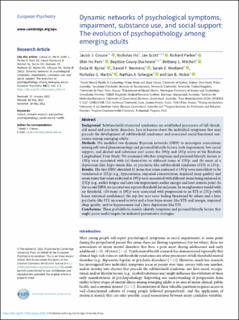| dc.contributor.author | Crouse, Jacob J. | |
| dc.contributor.author | Ho, Nicholas | |
| dc.contributor.author | Scott, Janine Linda | |
| dc.contributor.author | Parker, Richard | |
| dc.contributor.author | Park, Shin Ho | |
| dc.contributor.author | Couvy-Duchesne, Baptiste | |
| dc.contributor.author | Mitchell, Brittany L. | |
| dc.contributor.author | Byrne, Enda M. | |
| dc.contributor.author | Hermens, Daniel F. | |
| dc.contributor.author | Medland, Sarah E. | |
| dc.contributor.author | Martin, Nicholas G. | |
| dc.contributor.author | Gillespie, Nathan A. | |
| dc.contributor.author | Hickie, Ian B. | |
| dc.date.accessioned | 2023-01-24T14:52:22Z | |
| dc.date.available | 2023-01-24T14:52:22Z | |
| dc.date.created | 2022-09-22T14:08:04Z | |
| dc.date.issued | 2022 | |
| dc.identifier.citation | European psychiatry. 2022, 65 (1), . | en_US |
| dc.identifier.issn | 0924-9338 | |
| dc.identifier.uri | https://hdl.handle.net/11250/3045948 | |
| dc.description.abstract | Background
Subthreshold/attenuated syndromes are established precursors of full-threshold mood and psychotic disorders. Less is known about the individual symptoms that may precede the development of subthreshold syndromes and associated social/functional outcomes among emerging adults.
Methods
We modeled two dynamic Bayesian networks (DBN) to investigate associations among self-rated phenomenology and personal/lifestyle factors (role impairment, low social support, and alcohol and substance use) across the 19Up and 25Up waves of the Brisbane Longitudinal Twin Study. We examined whether symptoms and personal/lifestyle factors at 19Up were associated with (a) themselves or different items at 25Up, and (b) onset of a depression-like, hypo-manic-like, or psychotic-like subthreshold syndrome (STS) at 25Up.
Results
The first DBN identified 11 items that when endorsed at 19Up were more likely to be reendorsed at 25Up (e.g., hypersomnia, impaired concentration, impaired sleep quality) and seven items that when endorsed at 19Up were associated with different items being endorsed at 25Up (e.g., earlier fatigue and later role impairment; earlier anergia and later somatic pain). In the second DBN, no arcs met our a priori threshold for inclusion. In an exploratory model with no threshold, >20 items at 19Up were associated with progression to an STS at 25Up (with lower statistical confidence); the top five arcs were: feeling threatened by others and a later psychotic-like STS; increased activity and a later hypo-manic-like STS; and anergia, impaired sleep quality, and/or hypersomnia and a later depression-like STS.
Conclusions
These probabilistic models identify symptoms and personal/lifestyle factors that might prove useful targets for indicated preventative strategies. | en_US |
| dc.language.iso | eng | en_US |
| dc.publisher | Cambridge University Press | en_US |
| dc.rights | Navngivelse 4.0 Internasjonal | * |
| dc.rights.uri | http://creativecommons.org/licenses/by/4.0/deed.no | * |
| dc.title | Dynamic networks of psychological symptoms, impairment, substance use, and social support: The evolution of psychopathology among emerging adults | en_US |
| dc.title.alternative | Dynamic networks of psychological symptoms, impairment, substance use, and social support: The evolution of psychopathology among emerging adults | en_US |
| dc.type | Peer reviewed | en_US |
| dc.type | Journal article | en_US |
| dc.description.version | publishedVersion | en_US |
| dc.source.pagenumber | 0 | en_US |
| dc.source.volume | 65 | en_US |
| dc.source.journal | European psychiatry | en_US |
| dc.source.issue | 1 | en_US |
| dc.identifier.doi | 10.1192/j.eurpsy.2022.23 | |
| dc.identifier.cristin | 2054400 | |
| cristin.ispublished | true | |
| cristin.fulltext | original | |
| cristin.qualitycode | 2 | |

